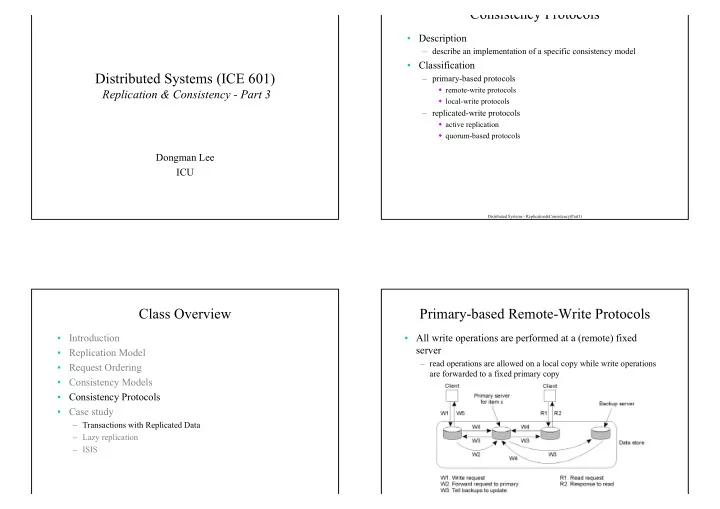

Consistency Protocols ‣ Description — describe an implementation of a specific consistency model ‣ Classification Distributed Systems (ICE 601) — primary-based protocols � remote-write protocols Replication & Consistency - Part 3 � local-write protocols — replicated-write protocols � active replication � quorum-based protocols Dongman Lee ICU Distributed Systems - Replication&Consistency(Part3) Class Overview Primary-based Remote-Write Protocols ‣ Introduction ‣ All write operations are performed at a (remote) fixed server ‣ Replication Model — read operations are allowed on a local copy while write operations ‣ Request Ordering are forwarded to a fixed primary copy ‣ Consistency Models ‣ Consistency Protocols ‣ Case study — Transactions with Replicated Data — Lazy replication — ISIS
Primary-based Remote-Write Protocols (cont.) Active Replication ‣ Issues ‣ Each replica performs update operations and propagates them (or the results) to the others — update can be a performance bottleneck if implemented as a blocking operation — requires totally ordered multicast � but guarantees sequential consistency (most recent write as the ‣ Replicated invocation problem result of a read) � if implemented as a non-blocking, the protocol provides no guarantee of sequential consistency and fault tolerance Distributed Systems - Replication&Consistency(Part3) Distributed Systems - Replication&Consistency(Part3) Primary-based Local-Write Protocols Active Replication (cont.) ‣ All write operations are performed locally and forwarded to the rest of ‣ Solutions to the replicated invocation problem replicas — group coordinator — primary copy migrates between processes that wish to perform a write — sender-driven vs. receiver-driven operation — Multiple, successive writes can be done locally (via non-blocking protocol) — can be exploited in mobile computing
Quorum-based Protocols Transactions with Replicated Data ‣ Require clients to request and acquire the permission of ‣ Replicated transactions multiple servers before any operation on replicas — transactions in which a physical copy of each logical data item is replicated at a group of servers (replicas) — quorum set ‣ One-copy serializability � W > half the total votes � R + W > total number of votes for group — effects of transactions performed by various clients on replicated � any pair of read quorum and write quorum must contain common copies, data items are the same as if they had been performed one at a time so no conflicting operations on the same copy on single data item � read operations — to achieve this � check if there is enough number of copies >= R � concurrency control mechanisms are applied to all of replicas � perform operation on up-to-date copy � 2PC protocol becomes two level nested 2PC protocol � write operations � phase 1 � check if there is enough number of up-to-date copies >= W » a worker forwards ”ready„ message to replicas and collects answers � perform operation on all replicas � phase 2 » a worker forward ”commit„ message to replicas — primary copy replication: concurrency control is only applied to primary Distributed Systems - Replication&Consistency(Part3) Distributed Systems - Replication&Consistency(Part3) Quorum-based Protocols (cont.) Transactions with Replicated Data (cont.) ‣ Examples ‣ Available copies replication — designed to allow for some replicas being allowed unavailable — client‚s Read operation is performed on any of available copy but Write operation on all of available copies — failures and recoveries of replicas should be serialized to support one-copy serializability � local validation � a transaction checks for any failures (and recoveries) of replica managers of objects it has accessed before it commits T U Client + front end Client + front end a) A correct choice of read and write set getBalance(B) deposit(A,3); b) A choice that may lead to write-write conflicts since W <= N/2 getBalance(A) deposit(B,3); Replica managers B c) A correct choice, known as ROWA (read one, write all) M B B A A N X Y P
Transactions with Replicated Data (cont.) Transactions with Replicated Data (cont.) ‣ Network partition ‣ Quorum consensus — can separate a group of replicas into subgroup between which — operations are only allowed when a certain number of replicas (i.e. communications are not possible quorum) are available in the partition — assume that partition will be repaired � possible only one partition can allow operations committed so as to prevent transactions in different partitions from producing — resolutions inconsistent results � optimistic approach — performed using Quorum-based protocol � available copies with validation ‣ Virtual partition � pessimistic approach � quorum consensus — combination of quorum consensus (to cope with partition) and � virtual partition available copies algorithm (inexpensive Read operation) Client + front end — to support one-copy serializability, a transaction aborts if replica Client + front end Network U T partition fails and virtual partition changes during progress of transaction deposit(B,3) withdraw(B, 4) — when a virtual partition is formed, all the replicas must be brought B up to date by copying from other replicas Replica managers B B B Distributed Systems - Replication&Consistency(Part3) Distributed Systems - Replication&Consistency(Part3) Transactions with Replicated Data (cont.) Transactions with Replicated Data (cont.) ‣ Virtual partition (cont.) ‣ Available copies with validation — virtual partition creation — available copies algorithm is applied to each partition � phase 1 — after partition is repaired, possibly conflicting transaction is � initiator sends Join request to each potential replica with logical timestamp validated � each replica compares timestamp of current virtual partition � version vector can be used to check validity of separately committed » if proposed time stamp is greater than local one, reply yes data items » otherwise, no � precedence graphs can be used to detect conflicts between Read and � phase 2 Write operations between partitions � if initiator gets sufficient Yes replies to form read and write quora and send � only feasible with applications where compensation is allowed confirmation message with list of members � each member records timestamp and members Network partition Virtual partition Replica managers X V Y Z
Recommend
More recommend